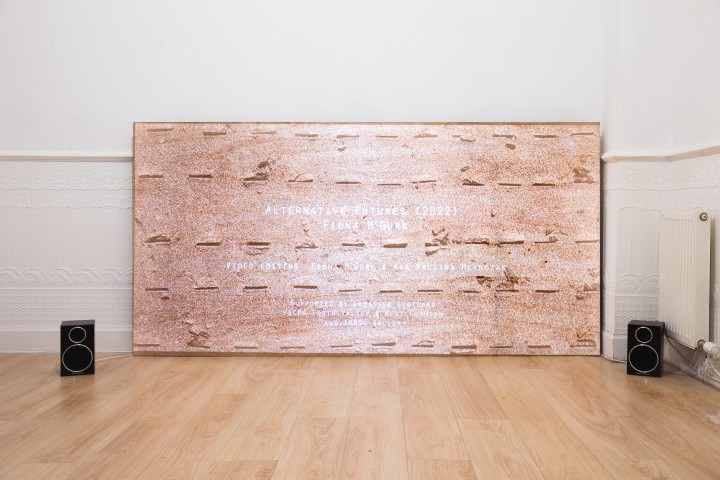Scottish Art News
Latest news
Magazine
News & Press
Publications
Data Dredging
By Greg Thomas, 21.03.2022

A double‐header curated by Aga Paulina Młyńczak at 16 Nicholson Street explores the intersections between physical and virtual landscapes. Greg Thomas reviews a set of new works by Moira Salt and Fiona McGurk.
Charred and oiled branches of driftwood hang at squint angles in the ground‐floor gallery at 16 Nicholson Street — like obscure written markings or streaks of paint rendered in three dimensions. This is Moira Salt’s Sustain, a posture, a striking if ambivalent arrangement perhaps suggesting fragments of a ruined landscape, or nature in recovery after some terminal event (one branch, balanced vertically, rests in a pile of soil as if it might re‐root itself). In a corner alcove, a trio of cyanotypes printed on a fabric sheet (Salt’s Erratics I) hangs above another mound of earth, showing a faint rocky landscape with central feature that could be the gable‐end of a ruined cottage or just a mass of rock.
Land art for an era of ecological anxiety, perhaps? (An accompanying sound piece features the lines “a thousand piles of trash burned today/ we had to cover our mouths and noses and ears/ not to get any more of our friends’ ashes into our lungs”). On the first‐floor these themes and motifs are modulated through Fiona McGurk’s Data Shadow, a network of hanging sheets of paper visualising various “historical methods of data collection, protection and interpretation.” Printed on both sides, the images blend into each other in the rays of the sun; CCTV stills bleed into street‐maps and lines of excised or erased text suggesting medical or military records. The assemblage is moored to the ground with smooth white boulders, echoing the appearance of smaller white stones in some of the images. Again, meaning is not crystalline here, but the cluster of images and text plays at the fringes of real and virtual environments, bringing bodies into collision with systems of measurement that define and constrain their movement or determine aspects of their administrative identity.
Towards the back of the room, a row of little glass panels buttressed in a bed of small stones shows different sections of a hand‐traced map of New York, certain sections filled in with red paint‐pen. A video‐screen inset horizontally into a white plinth documents the process of the map’s erasure, while the rhythm of the line of stones is carried across a section of wall as a thin red strip, like a fragment of subway map. It’s through the notes accompanying this work, McGurk’s Redline, that we get the clearest sense of the themes that might bind the show together: data systems and data mapping as weapons for enforcing the interests of power and wealth. The blocking out of neighbourhoods on the map represents waves of migration across Brooklyn due to gentrification and economic exclusion (redlining is “a practice of withholding services [financial and otherwise] from potential customers who reside in neighbourhoods classified as ‘hazardous’ to investment; the residents largely belong to racial and ethnic minorities”).
 Installation at 16 Nicholson Street. Photo by Bart Urbański.
Installation at 16 Nicholson Street. Photo by Bart Urbański.
Video‐works occupy the top floor. In Salt’s The Dirt Eaters – named after the practice of “geophagy”, generally understood to have been brought to North America with enslaved African populations – a digitally rendered body traverses a desolate virtual landscape that shifts in and out of focus. Diagrams, arrows, and cursors seem to orientate the viewer’s progress across this wilderness, while through headphones a conversation unfolds about ground poisoning through toxic waste on the Loxahatchee River in Florida. A former resident talks about a whole family in a mainly black housing development opposite a chemical waste dump that succumbed to cancer. Real landscapes, virtual landscapes; real bodies, virtual bodies. The intangible administrative systems that map out physical spaces and determine the fate of real people again seem to be broached.
On a larger screen across the room, individual glass panels are planted in the wet sand of an empty beach, the tide rushing through the speakers (in another small alcove space, a photo‐ print showing an aerial view of the same strips hangs above a square of sand containing their imprints). This work, McGurk’s Alternative Futures, seems to propose a utopian landscape in which equitable living conditions are possible. The organic imagery dovetails with the atmospherics of Salt’s soil and blackened wood—an ambivalent but hopeful note is struck, centred on a post‐digital sensory domain.
This is a show that suspends a delicate network of codes and symbols just beyond the threshold of easy understanding, while the exhibition notes distil a quality of intentional obscurity. Whether this is a strength or flaw – or simply a notable characteristic – of the work on display must be a matter of individual judgement. But much of the imagery roots itself in the mind.




